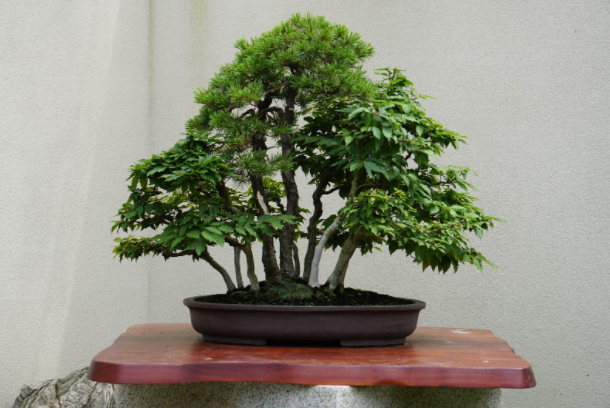The forest planting as it stands in the Museum today.
Uncertain times provide many reasons to look toward nature for calm and healing. Myriad research has pointed to how natural environments, especially trees, can benefit our health and overall well-being.
But as this month's Historical Tree Spotlight shows, nature also provides the inarguable fact that diversity is not just important but fundamentally essential to life. This month’s focus is an unorthodox forest planting, often referred to as “The Mixed Forest,” located in the Japanese Pavilion.
Donated by Nobusuke Kishi, a former prime minister of Japan, this planting has been in training since 1935 and is part of the group of trees that established the National Bonsai & Penjing Museum’s collection in 1976.
The planting consists of various tree species – including hornbeams, Japanese white pines and Japanese beeches – collected as seedlings from Mount Fuji and Mount Ishizuchi in Japan. Museum Curator Michael James said plantings of multiple species are rare because the grower has to incorporate all of the individual care needed for each species, instead of providing the same care to the whole pot.
But James said mixed plantings are actually a better representation of the natural world – forests aren’t monocultures but complex systems home to copious varieties of plants and organisms.
He added that even though the planting is home to different species, each tree has the same needs: air, water and nutrients.
“We care for these forests in a way that accommodates the different needs of each species and allow them to all be healthy in the same environment,” James said.
The planting featured in a 1975 publication.
Helping a Mixed Forest Thrive
Tending to each tree’s growing requirements is somewhat of a balancing act. James said the pot contains two soil types in separate areas to cater to the different species’ watering needs.
The middle of the pot, where the pines are planted, is filled with a mixture high in pumice, which helps the soil dry out faster as pines tend to thrive in drier soils. The pines are situated on the top of a small slope, which allows the soil to drain more easily, James said.
But the beeches and hornbeams – deciduous trees – require a bit more water than pines, so the trees are planted in a wetter mixture. James said Museum staff mainly water around the edges of the pot, where the deciduous roots are concentrated, to help control the wet and dry areas.
Learn more about different soil and fertilization techniques in our Bonsai Basics blog.
James added that pruning care also differs among species. The white pines are single-flush trees and require branch shortening without losing any candles, or new growths.
“We also pluck needles to balance the strength of the pines,” James said.
But the apices and higher branches of deciduous trees have to be pinched and frequently pruned to allow sunlight to filter through to lower branches.
“They’re all competing for a limited amount of resources like sun, nutrients and water,” James said. “Without that thinning process, the lower branches end up getting weak and less dominant trees will die.”
A picture of the forest planting taken in 1977.
Benefits of Mixed Plantings
James said this planting is exemplary of the many benefits to diversity, both in naturally occurring forests and in human society, as each part of the small ecosystem contains instances of mutualistic relationships.
“This forest has a lot of symbolic meaning right now and is a good metaphor for the importance of diversity not only in plants but in people,” he said.
Mycorrhizal fungi, found in the root systems of plants, facilitate plants’ water and nutrient absorption. Plants in return funnel down carbohydrates formed during photosynthesis.
James said the fungal web also serves as a method of chemical communication between plants, creating a bond throughout plantings or forests.
“If one plant is attacked by an insect, plants on the other side of a forest through that fungal connection can tell that the plant’s being attacked and can produce chemicals to protect against the attack before the insect gets to it,” he said.
James added that upper canopy trees also use the mycorrhizal network to provide carbs and nutrients to trees below that are deprived from sunlight and sugars. Additionally, the pines stretch toward the sun, giving needed shade to the deciduous trees – analogous to a natural forest.
“The different species, fungal organisms and animals all benefit from diversity,” James said.






